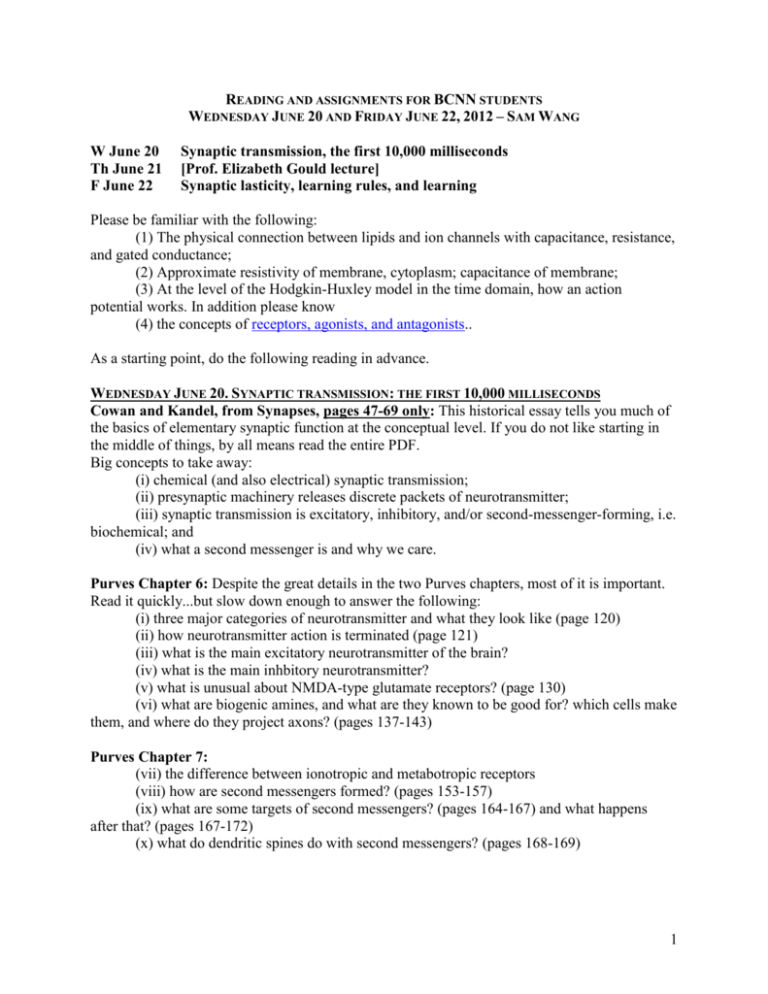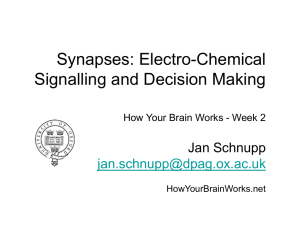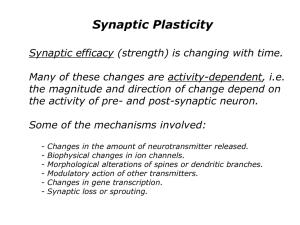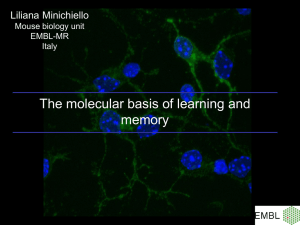Reading and assignments for BCNN students
advertisement

READING AND ASSIGNMENTS FOR BCNN STUDENTS WEDNESDAY JUNE 20 AND FRIDAY JUNE 22, 2012 – SAM WANG W June 20 Th June 21 F June 22 Synaptic transmission, the first 10,000 milliseconds [Prof. Elizabeth Gould lecture] Synaptic lasticity, learning rules, and learning Please be familiar with the following: (1) The physical connection between lipids and ion channels with capacitance, resistance, and gated conductance; (2) Approximate resistivity of membrane, cytoplasm; capacitance of membrane; (3) At the level of the Hodgkin-Huxley model in the time domain, how an action potential works. In addition please know (4) the concepts of receptors, agonists, and antagonists.. As a starting point, do the following reading in advance. WEDNESDAY JUNE 20. SYNAPTIC TRANSMISSION: THE FIRST 10,000 MILLISECONDS Cowan and Kandel, from Synapses, pages 47-69 only: This historical essay tells you much of the basics of elementary synaptic function at the conceptual level. If you do not like starting in the middle of things, by all means read the entire PDF. Big concepts to take away: (i) chemical (and also electrical) synaptic transmission; (ii) presynaptic machinery releases discrete packets of neurotransmitter; (iii) synaptic transmission is excitatory, inhibitory, and/or second-messenger-forming, i.e. biochemical; and (iv) what a second messenger is and why we care. Purves Chapter 6: Despite the great details in the two Purves chapters, most of it is important. Read it quickly...but slow down enough to answer the following: (i) three major categories of neurotransmitter and what they look like (page 120) (ii) how neurotransmitter action is terminated (page 121) (iii) what is the main excitatory neurotransmitter of the brain? (iv) what is the main inhbitory neurotransmitter? (v) what is unusual about NMDA-type glutamate receptors? (page 130) (vi) what are biogenic amines, and what are they known to be good for? which cells make them, and where do they project axons? (pages 137-143) Purves Chapter 7: (vii) the difference between ionotropic and metabotropic receptors (viii) how are second messengers formed? (pages 153-157) (ix) what are some targets of second messengers? (pages 164-167) and what happens after that? (pages 167-172) (x) what do dendritic spines do with second messengers? (pages 168-169) 1 FRIDAY JUNE 22. LEARNING, MEMORY, AND SYNAPTIC PLASTICITY The topic is learning in synaptic networks, on time scales ranging from minutes to a lifetime. One view, common among theorists, is that plasticity is largely predictable from the timing of presynaptic and postsynaptic spikes. A second view, held by cellular neurobiologists, focuses on molecular mechanisms including second messengers (for example, calcium) and neuromodulators (for example, dopamine), with the consequence that spike timing is only a small part of the picture. Finally, a third view, held by systems/cognitive neuroscientists, is that information storage is not write-once, read-many, but instead can change in location over long periods of time. I will cover as much of these views as time will permit. Breedlove SM et al., Chapter 17, Cognitive Neuroscience. From Biological Psychology, sixth edition. Sinauer Associates. Shouval HS, Wang SS-H, and Wittenberg GM. Spike timing dependent plasticity: a consequence of more fundamental learning rules. Frontiers in Computational Neuroscience 2010 Jul 1;4. pii: 19: An overview of the mechanisms underlying synaptic learning rules that depend on spike timing. For more see Caporale N and Dan Y 2008 Annual Review of Neuroscience http://pubmed.gov/18275283 Knudsen EI. Sensitive periods in the development of the brain and behavior. Journal of Cognitive Neuroscience 2004 16(8):1412-1425. This is likely to go beyond the day’s discussion, but describes important fundamental principles. 2 GENERAL OUTLINE The following notes give a conceptual outline of basic knowledge in these areas. During the lecture period, this outline will not be followed very closely! SYNAPTIC TRANSMISSION: THE FIRST 10,000 MILLISECONDS Some current problems that this topic speaks to: - Basis and interpretation of the fMRI SIGNAL - What do dendritic SPINES do? trapping chemical signals? electrical? specificity of plasticity and therefore network learning? opening up partner possibilities? - Can a single neuron change its FIRING PERSONALITY? persistent activity and input sensitivity - How do neurotransmitter and NEUROMODULATOR differ? dopamine TOPICS: I. The chemical synapse II. What synapses do pre- and postCentral synapses Dynamics of synapses Energetics of voltage-based signaling III. Second messengers IV. Dopamine >>>>>>>>>>>>>>> I. THE CHEMICAL SYNAPSE - Electrical synapses were around from the earliest gap junctions (connexins) good for synchrony and speed examples: inhibitory networks, circadian rhythm, inferior olive bidirectional (usually) sign bidirectional (usually) - Chemical synapses came later. now more common in most brains, vertebrate and invertebrate. Allows inhibition directional signaling second messenger signaling synapses: small gap, 20-40 nm (vs. 3.5 nm bilayer). 3 II. WHAT SYNAPSES DO PRESYNAPTIC: SIGNALING MOLECULES RELEASED BY NEURONS small-molecule neurotransmitters and neuromodulators neuropeptides growth factors (NGF, BDNF,...) exceptions: endocannabinoids (retrograde), nitric oxide (membrane-crossing) POSTSYNAPTIC: RECEPTORS i) channels (composed of subunits to make a working channel) ii) G protein coupled receptors (GPCRs) (composed of subunits - trimeric) iii) receptor enzymes (neurotrophin receptors, i.e. Trk proteins; usually a single protein) iv) intracellular receptors (e.g. steroid receptors - cell permeant, hours to days) Of particular interest to computational neuroscientists are i) and ii), which act in the millisecond-second range. IONOTROPIC RECEPTORS these are how we first learned about synaptic transmission they are also how signals get integrated over distances of more than a few microns (recall length constant) so they are central to thinking about neural tissue Historic and simple case, neuromuscular junction AchR: 2. 's bind ACh. the “nicotinic” ACh receptor (note each subunit has variants) vesicle fusion is a stochastic process...but the mean number of quanta released is ~100 so it's a reliable synapse other reliable synapses: CF-PC, squid giant synapse why ~100? NMJ is composed of large active zones many vesicles, response is reliable Reduce external Ca??? mean number is smaller. Katz and Miledi could get Poisson statistics Pr (N vesicles) = exp(-) N / N! A lot of what we know about NT release comes from Bernard Katz, therefore Nobel Prize w/HH - presynaptic terminal has voltage-gated Ca channels - Ca is low inside cells - APs cause Ca entry 4 - Ca is necessary and sufficient - EPSP is prompt, within 0.5 ms Neurotransmitter release is Ca-dependent The Ca sensor for synchronous release is synaptotagmin this is just one of dozens of vesicle and presynaptic proteins Note that Dodge and Rahamimoff found ([Ca]/[Mg])4 dependence! Ca near channel mouth is tens of micromolar at squid giant synapse, delay to ICa is ~0.5 ms, onset of Vpost ~0.7 ms so Ca must act within about 0.2 ms. sqrt(6Dt)=sqrt(6*0.2*0.2)=0.5 µm (or less!) So trigger of NT release is 1) fast 2) low-affinity for calcium 3) spatially tight with calcium channel Today, we now know about neurotransmitter (NT) release and action: - NT release is mediated by contents of vesicles - NTs are released by regulated exocytosis - NTs act on receptors, then are cleared or broken down - vesicles are re-formed and re-filled Other synaptic proteins: won’t discuss, too many and too large a subject in molecular neuroscience. For example, not addressed: SNARE hypothesis, clostridial toxins in food poisoning and tetanus. one is botulinum, which cuts synaptobrevin. botox! CENTRAL SYNAPSES SYNAPTIC TRANSMISSION Low probability synapses High probability synapses Short timescale dynamics: facilitation, depression The major neurotransmitters of the CNS are amino acid-based: glutamate, GABA (GAD), and glycine. ionotropic glutamate AMPA/kainate (inactivate, reverse at 0 mV, Na/K) NMDA receptors (don’t inactivate, reverse at 0 mV, Na/K/Ca!!1!!! OMG!) CENTRAL SYNAPSES ARE COMPARATIVELY WEAK AND UNRELIABLE Can also apply to CENTRAL SYNAPSES Central synapses can be WEAK and UNRELIABLE 5 CA3-CA1 synapses PF-PC synapses these are examples of roughly crossed pathways, where single terminals can be isolated more easily Probabilities are low. For instance CA3-CA1 Pr=0.2-0.8. Synapses can even be "silent" - no receptors (early in development; note NMDAonly receptors) or no release Summary: weak, unreliable, 1-10 pA, 1-10 ms Short-term DYNAMICS: FACILITATION AND DEPRESSION 10 ms - 1 s - FACILITATION 10 ms - 1 s - also SYNAPTIC DEPRESSION (note different from LTD) 1-10 s - AUGMENTATION 10-100 s - POST-TETANIC POTENTIATION mostly presynaptic - stem from dynamic changes in the vesicle pool readily releaseable pool (same? as docked vesicles), reserve pool depend on calcium (and other messengers) GENERALLY... ...at weak synapses the net effect is improved transmission of burst information. ...at strong synapses the net effect is paired-pulse depression (for example CF-PC) A digression on calcium. Calcium is an especially interesting second messenger kept at 100 nM normally, 1.3 mM externally in CSF Calcium is also important because it's a messenger we can observe! Facilitation uses a high-affinity trigger, different than release. there are evidently multiple sites for calcium. Other second messengers act upon presynaptic machinery as well. A major mechanism is PHOSPHORYLATION, possibly THE MOST IMPORTANT POST-TRANSLATIONAL MECHANISM FOR MODIFYING PROTEINS. This is a general principle that applies throughout cell signaling, not just the presynaptic terminal. Phosphorylation is very important in the first steps of synaptic plasticity. ENERGETICS OF NEURONAL AND SYNAPTIC SIGNALS Although they are unreliable on a single basis, in the aggregate they cost a lot of energy. Charging and discharging the membrane capacitance this is what APs and EPSPs/IPSPs do 6 Biochemical signals Longer-term processes (making protein, changing shape, building structures and cells) Alle et al. recently showed that APs might be a pretty small part of the energetic budget And this doesn't even count second messengers! So synaptic processing could potentially suck up the lion's share of brain energy. provides a way to think about fMRI fMRI measures increases in blood oxygenation, but the underlying mechanism is unknown. Synaptic activity and spikes have both been suggested as triggers, with recent evidence (LFP for instance) favoring the former. The results of Alle et al. suggest that costly synaptic signaling is evolutionarily well suited as a call signal for energy. III. SECOND MESSENGERS Formed by action of transmitter ("first messenger") IONOTROPIC BIG EXAMPLE: NMDA RECEPTOR AND CALCIUM Metabolic activity of GPCR (thus "metabotropic" receptor) Other enzymes (nitric oxide) METABOTROPIC RECEPTORS virtually all neurotransmitters have metabotropic receptors all neurotransmitter with ionotropic receptors have metabotropic targets as well (an exception: glycine) nicotinic...muscarinic Glu...mGlu GABA_A...GABA_B NTs activate enzymes (molecules that speed chemical reactions) Second messengers - made by enzyme activation (usually G protein-coupled receptors [GPCR], a really important superfamily) - destroyed - diffuse Amplification principle: 1 NT, dozens of Gs, each 1:1 with enzyme, many msgrs GPCRs are all over the body! In the brain: rhodopsin - light “receptor” in phototransduction. Transducin is G protein olfactory receptors serotonin - site of action of LSD, Ecstasy, Prozac 7 dopamine - cocaine, methamphetamine cannabinoids - marijuana opiates - heroin, hasish, Percocet, Oxycontin norepinephrine - modafinil hormones (original discovery of cAMP by Sutherland) Examples: AC >> cAMP PLC >> IP3 and diacylglycerol>PKC lithium, for depression, inhibits PLC Calcium can enter via channels, or be released from internal stores endocannabinoids } -- volume transmission! also retrograde!!1!1! nitric oxide (Ca > NOS) } -depolarization-induced suppression of excitation/inhibition SPATIAL AND TEMPORAL SCALES OF SIGNALING MECHANISMS DIFFUSION of second messengers is slower than voltage "diffusion" Diffusion equation: D*Cxx = Ct typical value: 200 µm2/s for IP3, 20 µm2/s for buffered Ca Cable equation: 1/ra Vxx = cm Vt Analogous quantity is 1/racm = ... lambda2/tau lambda = 10-100 µm, tau = 1-10 ms "D" is 10,000 µm2/s to 1,000,000 µm2/s WOW! Rule of thumb: <x2>1/2 = 2NDt where N=number of dimensions For this reason spines are thought of as chemical compartments Exception: smooth dendrites can generate regional chemical signals (i.e. removal alone) A common concept is that ionotropic is "fast" and metabotropic is "slow". But this is a myth. Recall Hodgkin-Huxley. Those were fast conductances (~1 ms) - yet we also heard about voltage-gated conductances that operated on time scales of 0.1 s or even longer. It's a similar story...though admittedly, metabotropic signaling tends to be about 10-100* slower. Consider phototransduction: pretty fast. Likewise, G signaling can be fast, ~50 ms Consider IP3-based signaling in Purkinje cells, ~30 ms to rise in Ca 8 ...fast enough to shape a timing-dependent synaptic learning rule. Some neurotransmitters work mainly through metabotropic receptors biogenic amines: dopamine, norepinephrine, serotonin neuropeptides (neuropeptide Y, somatostatin,...) Downstream effects (important for plasticity): KINASES (PKC, CaMK, about a hundred others) and PHOSPHATASES (only about four of these). TRANSCRIPTION FACTORS such as CREB (cAMP response element binding protein) Metabotropic receptors can affect ion channels EXAMPLE 1: 5-HT and PERSISTENT FIRING - L-TYPE CURRENT (maybe Nap too?) EXAMPLE 2: BACK-PROPAGATION INTO DENDRITES ACh >> mAChR --| M-current, a potassium current IV. DOPAMINE AS A REWARD SIGNAL Dopamine: made by substantia nigra (why it’s black; polymerizes to the same stuff as squid ink) 7000 dopaminergic neurons per substantia nigra in rats 200,000 in monkey or human targets in many brain regions prefrontal cortex, striatum/nucleus accumbens, basal amygdala behavioral significance: cognitive, reward, movement (Parkinson’s disease), affect (schizophrenia) Receptors: D1 (high-affinity), D2 (low-affinity) also have various states, partly due to desensitization mechanisms D1 --> AC --> ^ cAMP, D2 --| AC --> v cAMP Kinetics of dopamine in the striatum are fast Fastest release and uptake measured voltammetrically in caudate-putamen (CP) and nucleus accumbens (NAc). Slower in medial prefrontal cortex (mPFC) and basal lateral amygdaloid nucleus (BAN). Garris and Wightman 1994, Gonon 1997. Many downstream effects on ion channels and synaptic plasticity Evidence from brain slices. In striatum, where the effects are largest and the experiments most numerous: 9 D1 - decrease in Na current, increase in Kir2, varied effects on Ca currents (PKA/PP1) D2 - mixed effects on Na current and Kir2, increase in V-dependent K current mechanisms depend on both kinases and phosphatases seems to modulate synaptic strength and ability to undergo plasticity as well could be downstream effect of effects on voltage-gated channels One effect is the development of a plateau. Schultz / Hernandez-Lopez et al 1997 Also effects on voltage-gated conductances in prefrontal cortex (for instance L5/6 neurons) smaller effects. seem to attenuate efficacy of apical inputs, also make neurons more excitable increase back-propagation of APs into dendrite in some pyramidal neurons, and therefore may improve associative plasticity The problem with most slice experiments: slow application of dopamine These effects could be larger. Receptor mechanisms desensitize so that steady-state effects are usually not as large as transient effects. Therefore anything done in a slice is probably a lower bound on true physiological effect. 10 Plasticity and learning rules I. Different kinds of plasticity II. Time scales of plasticity III. Molecular triggers of plasticity (induction) IV. Downstream mechanisms of plasticity (expression) V. Learning rules HEBB PRINCIPLE Cells that fire together wire together this principle appears in both adult and in developing tissue Bliss and Lømo discovered LTP Mayford - tagging of active neurons I. DIFFERENT KINDS OF PLASTICITY Later, development of the nervous system, when major pathways are being laid down. A period of considerable change. Within the field this is usually referred to as neural plasticity. During development: growth and retraction, remodeling of dendrites and axonal arbors, building of neural circuits and maps. In the mature brain, change is still possible, but it occurs on a smaller scale. For example, a new synapse can form, but generally a new dendrite or axon cannot. The exception is adult neurogenesis, but this only happens in some brain regions. Plasticity in mature brains takes place at the molecular and cellular level. - excitable properties of neurons and circuits (epilepsy) - synaptic strength (initial stages of memory formation and other information storage) - intracellular machinery (addiction) Some kinds of change are programmed. Some are use- and activity-dependent. II. TIME SCALES OF PLASTICITY (continuing from yesterday) minutes: LTP and LTD expression. minutes-hours-...: spine formation hours-days...: L-LTP, protein synthesis days...: structural change in circuits [??] ocular dominance column formation homeostatic plasticity somatosensory remodeling 11 Relationship of synaptic (and other) plasticity to learning and memory Different types of memory (different brain regions) Time scales of memory Note that from a theorist’s point of view, memory is weight change However, memory is empirically not a static thing Sleep - evidence for reconsolidation disrupt sleep, memories are not reconsolidated not a stress response: adrenalectomized animals still have impaired consolidation Also, there is much more than weight change Finally...the location of memory storage is not fixed over time. STORED CHANGE CAN EVEN MOVE BETWEEN BRAIN REGIONS. III. TRIGGERS OF SYNAPTIC PLASTICITY (INDUCTION) Synaptic plasticity: changes in circuit properties that can take place without morphological change. LTP, LTD. Interesting for two reasons: - earliest measurable sign of an impending change - technically tractable in slice or even cell culture Induction v. expression in synaptic plasticity: INDUCTION - the biochemical signal that leads to long-lasting change example: biochemical signal EXPRESSION - the cellular changes that instantiate LTP or LTD example: insertion of receptors, or changes in phosphorylation INDUCTION leads to EXPRESSION Famous induction signals: cAMP, calcium Gunther Stent proposed a molecular coincidence detector Now: NMDA receptor, IP3 receptor GOING FROM INDUCTION TO EXPRESSION synaptic activity >> chemical signals >> targets >> long-term change NMDA receptor, a coincidence detector second messengers CaMKII, a molecular switch bidirectional plasticity and phosphatases Example where it’s best studied: CA3-CA1. axons are all aligned, as are dendrites. also important because of role in hippocampus Properties of LTP and the NMDA receptor how does NMDA receptor account for the properties of LTP? 12 cooperative - weak stim no, strong stim >> LTP associative - weak paired with strong >>LTP input-specific - LTP doesn’t spread to second pathway talk about LTP induction only (ignore LTD for a moment) CaMKII Ca’s target: CaMKII, 2% of protein of brain! IV. EXPRESSION MECHANISMS FOR LTP. (CONVERSE FOR LTD) Sites for expressing LTP and LTD change probability of glutamate release more glutamate per quantum more conductance per AMPA receptor more AMPA receptors synapse change/growth (e.g. synapse “splitting”) Tests for a postsynaptic locus quantal analysis again - successes get larger apply glutamate to see if change in sensitivity occurs (hard because of optical limits) tag GluR with GFP (Nobel tool), see it go in Tests for a presynaptic locus quantal analysis - failure analysis paired-pulse facilitation On longer time scales: recruitment of proteins to synapse (viz GRIP, psd95) tagging (needed for delivery of proteins to plastic synapse) splitting of synapses the picture is CaMKII>AMPA-R delivery, cytoskeletal changes in GRIP, ABP (scaffolding) recent development: not just receptor channels inserted. other channels are inserted too: voltage-gated channels! leads to changes in the excitable properties of dendrites. (Daniel Johnston, UT Austin) processing by the presynaptic side (harder) vesicle pools: readily releasable, total population. cycling facilitation if statistics of responses follow a Poisson distribution P=Lke-L/k! a simplified version of this is failure analysis (k=0) P(0)=e-L then the failure rate should reveal something about what the presynaptic terminal does 13 silent synapses - postsynaptic change yet failure rate changes After LTP/LTD: structural change? V. LEARNING RULES “ATOMS” OF PLASTICITY: ALL-OR-NONE? CaMK calcium dependent and autonomous exists as a 12mer once phosphorylated, becomes autonomously active. a positive feedback system! believed that CaMK subunits can phosphorylate their neighbors CaMK activation could snowball - implies that it might be all-or-none a molecular switch? plasticity begins as an all-or-none event change can be presynaptic or postsynaptic what does CaMK do? Population plasticity - at this level plasticity is graded suggests that LTP in bulk is summed change at many synapses the “atoms” of plasticity single synapse LTP is all-or-none (maybe LTD too) BIDIRECTIONAL PLASTICITY stimulus conditions for LTD at CA3-CA1 - Dudek and Bear curve LTP and LTD have common mechanisms: APV blocks both BAPTA blocks both caged Ca can cause both so Ca is necessary and sufficient. it triggers both. how??? how can this be? phosphatases LTP and LTD have common mechanisms: APV blocks both BAPTA blocks both caged Ca can cause both 14 so Ca is necessary and sufficient. it triggers both. how??? how can this be? phosphatases - calcineurin (activated by low levels of Ca) block kinase - no LTP. block phosphatase no LTD. suggests moderate Ca > phosphatases LTD. suggests high Ca > both, then LTP. caged Ca: short bursts big>ltp, long small>ltd. camkii substrate <--> substrate-P calcineurin moderate Ca (1 uM) vs. high Ca (10 uM) 100x 100 hz 300-900x 1 hz Spike timing dependent plasticity Beyond spike timing dependent plasticity: much more! see Shouval reading. Breakdown of synapse-specificity. Ca signals are compartmentalized but what about downstream steps? Harvey/Svoboda: using 2-photon uncaging of glutamate, LTP is spine specific. neighboring spines become more sensitive to LTP induction, threshold lower for 10 min over 10 um of dendrite. An example of a spreading signal is Ras activation. On time scales of weeks, months, and years, information appears to be transferred between brain regions. Examples: (i) H.M.’s retrograde amnesia – consolidation. (ii) Brain regions involved in tasks such as reading, musical instrument playing, eyeblink conditioning...all show different anatomical dependence over long periods. (iii) Developmental change –lesions have different effects depending on whether they occur in infancy, childhood, or adult life. Example: cerebellar damage and autism. 15







